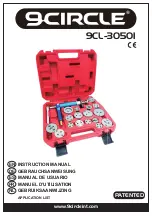
409-32048
Rev A
15
of 64
The editor can be accessed from the icon at the bottom of the screen. The following fields are maintained in the
data base.
Entries
“Tool Name”
-
This is a name you choose up to 20 characters long, spaces allowed, that will be used to
refer to this tool in the future. Enter the name from the keyboard.
“Tool Id”
-
This is th
e unique code that is programmed into the tool holding plate’s ID memory device.
NOTE
Note: No two tools should ever have the same number unless one is a spare tool mounted on a tooling plate. Only one entry is
made in the database.
“Tool Height”
-
The tool height information is needed in order to know the pressed height of the
connector. Enter the height of the tool as measured from the top surface of the tool holder plate to the part
of the tool (usually the end) that does the pressing. Top tools should be 56.8 ±0.5 mm [2.236 ±.020 in.]
including tool bar. Enter the number from the keyboard.
“Tool Width”
-
This is used for drawing the PCB assembly rendering on the screen and for collision
avoidance with obstructions. Enter the width of the tool at the widest points. Maximum tool width is
25.4 mm [1.00 in.] centered on tool bar.
“Tool Length”
-
This is used for drawing the PCB assembly rendering on the screen and for collision
avoidance with obstructions. Enter the length of the tool at the longest point. Maximum tool length is
203 mm [8.00 in.]centered on tool bar.
“Comments”
-
Enter any comments desired such as a short description of the tool application.
5.2.
Profile Editor
Purpose
The pressing Profile is information that is used to control the pressing process including speed, force, and
height. It is at the heart of the control sequence, and allows the user to define in detail how fast, how far,
and with how much force a connector is pressed into the PCB. Profiles are stored as ASCII files with a
user-specified name. The .prf extension is automatically added. The files can be viewed in any text editor.
See Figure 13.
Figure 13
Profile Editor Screen
















































